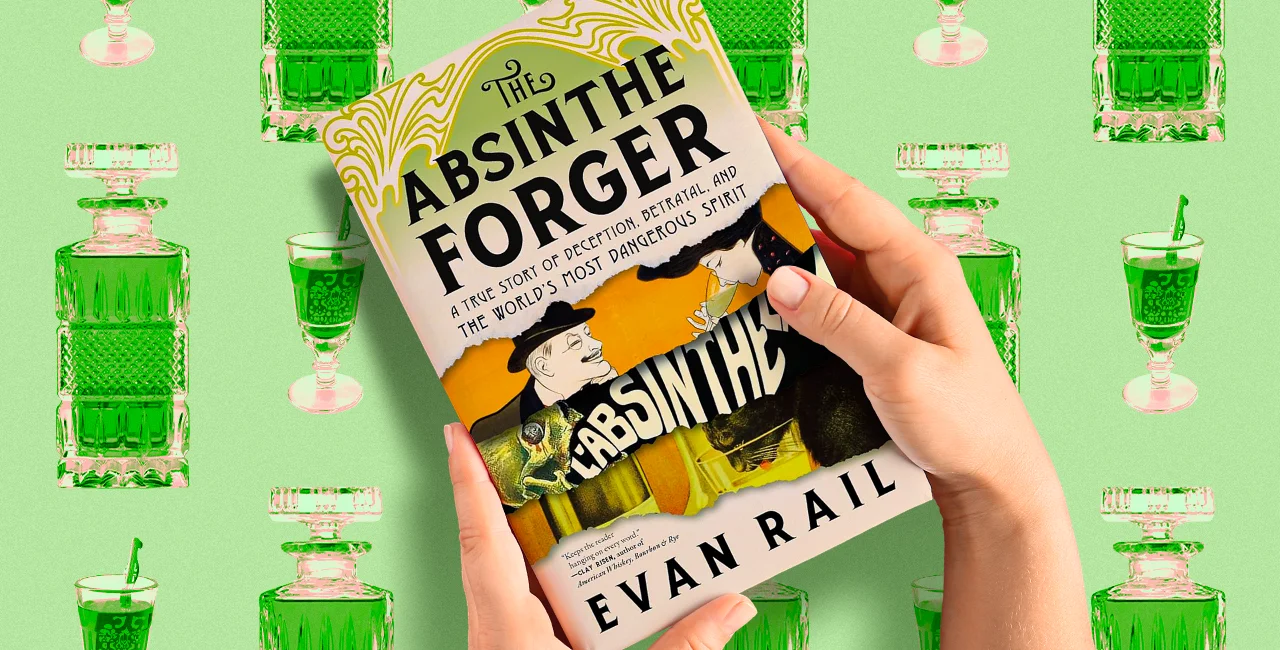After indulging a bit too much—by his own admission—in absinthe tasting while researching a New York Times piece some years ago, Evan Rail decided to leave the mystical green spirit on a top shelf, where it gathered dust for several years.
But some stories are just too good to pass up.
PARTNER ARTICLE
“It’s a remarkable thing to be a travel and food writer and find a relevant true-crime story,” he tells Expats.cz. “When I came across this particular story and individual, it overcame any reluctance I might have had.”
Published last month, The Absinthe Forger: A True Story of Deception, Betrayal, and the World’s Most Dangerous Spirit recounts the true story of Christian [not his real name], a London-based conman who created his own absinthe forgeries. He produced modern compositions, blending new flavors and other spirits, then sold them to online collectors as rare, high-value versions of the mysterious spirit.
“I wanted to know more about the collector’s mentality, what drove people to buy old bottles for thousands of dollars, as well as to try to understand why Christian, whoever he was, had done what he had done,” Rail writes in his book.

This true-life tale of betrayal serves as the foundation for Rail’s deep dive into the turbulent history of a drink that has bewitched and baffled generations of drinkers.
Created in Switzerland’s canton of Neuchâtel in the late 18th century, absinthe was originally a mix of wormwood, anise, and fennel. Production soon moved across the border to France, around Pontarlier. According to Rail, by the end of the century, distilleries in the area were producing over 20 million liters per year, fueling a sharp rise in consumption across France, Europe, and the United States.
Like other spirits that emerged around the same time, including Czechia’s beloved Becherovka, absinthe was initially created as a medicinal drink due to wormwood’s anti-parasitic properties. French soldiers in Algeria and other African colonies consumed it to treat malaria and other diseases, eventually spreading rapidly among France’s high society, Bohemian circles, and working-class neighborhoods.
Devil in a bottle
Its reputation, however, soon took a turn for the worse. “The taste for absinthe was so great that cheaper versions – effectively poison – started being sold, especially to the poor,” Rail explains.
Attracted by the drink’s alluring appearance, rumored hallucinogenic properties, and the mystique of the “green fairy,” Romantic poets, tortured painters, and decadent artists quickly adopted absinthe as their drink of choice. They featured it prominently in their writings, compositions, and paintings, likely contributing to its growing ill-repute.
“Verlaine was drunk on absinthe when he shot Rimbaud, and the spirit was also blamed for Van Gogh, a known copious drinker, cutting off his own ear,” Rail notes. Other famous figures—from Degas and Toulouse-Lautrec to Baudelaire, Wilde, and Hemingway—are also associated with the drink.

But the roots of the problem ran deeper. “By the end of the 19th century, society was looking for something to blame for the decline of French civilization,” Rail tells Expats.cz.
Fueled by campaigns to protect French and European wine devastated by the phylloxera epidemic, amplified by media reports linking absinthe to violent crimes, and bolstered by pseudo-scientific studies warning of the dangers of “absinthism,” a nationwide ban was imposed across much of the Western world in the 1910s.
While some countries, influenced by the temperance movement, cracked down on alcohol in general, “absinthe is the only drink that was specifically targeted and banned,” Rail emphasizes.
“There is no spirit in the world that has been banned almost everywhere on the planet for nearly a century. No other spirit has been so maligned and treated as evil. And no other drink has so much mystery and romance around it,” Rail told Radio Prague.
One of the few nations to avoid the prohibition trend was Czechoslovakia, a newly-formed country emerging from the rubble of the Austro-Hungarian empire and World War I.
A Czech revival
“Absinthe wasn’t really present here during the First Republic, nor did it exist under the Communist regime,” Rail says, though he notes that many prominent Czech artists and cultural figures lived in France at one point before the ban.
One testament to their acquaintance with the drink is Viktor Oliva’s famous painting The Absinthe Drinker, which is displayed today at Prague’s Café Slavia.
“Because it was never banned here, production mushroomed in post-1989 Czechoslovakia and the Czech Republic,” Rail adds. “It was a time of optimism when people were trying new things. It must have been liberating for a distiller wanting to create their own product to turn to absinthe at a time when most of the world couldn’t.”
Produced in the Czech Republic, the Hill’s brand played a significant role in absinthe’s global renaissance, Rail says, though he notes that it’s not one he would recommend drinking. Following the Czech revival, absinthe began to be exported and sold across Europe, where countries gradually lifted their near-century-long bans in the early 2000s.

Absinthe also entered pop culture, appearing in films like Francis Ford Coppola’s Bram Stoker’s Dracula (1992) and the 2001 musical Moulin Rouge!, both of which capitalized on the drink’s mystique and dreamlike aura for global audiences.
“Absinthe is a wonderful and widely underappreciated drink,” Rail says. “It doesn’t deserve to be demonized.” Still, he adds, there is something distinct about it, largely due to the presence of the thujone neurotoxin found in wormwood.
Whether fetishized for its pre-ban vintage bottles, idealized as an art form never to be opened, consumed as part of a communal ritual, or experienced in its modern-day variations, there are many ways to get acquainted with the 'green fairy' today.
Drinking absinthe in Prague
While absinthe has returned to bars, it will never become a mainstream drink, according to the author. “Absinthe is romantic; people love the idea of it, but it will never be the most popular beverage in the average bar,” says Rail, whose book aims to uncover the drink’s rich cultural history and promote a more refined appreciation, both for amateurs and connoisseurs alike.
For those unsure about the taste, Rail recommends starting with cocktails containing just a touch of absinthe, such as a Sazerac, to avoid feeling overwhelmed.
Though serving absinthe from an ornate fountain filled with ice and water may add to the ritual’s stylishness, Rail prefers to keep it simple. He mixes absinthe with ice water in a 1:1 or 2:1 ratio, which gives it its signature cloudiness without adding sugar.
For Rail, whose previous books focused on beer and Czech brewing culture, the best places to try absinthe in Prague include L’Fleur in the Jewish Quarter, where you’ll find “spectacular” absinthes distilled by Czech producer and historical spirits collector Martin Žufánek and Absintherie Jilská, a short walk from Old Town Square.
Among brands, the Swiss La Clandestine is a favorite, and Rail is also looking forward to trying Prince d’Absinthe by Prague-based producer Petr Šlechta.
He cautions against the “Bohemian-style method,” which involves setting absinthe on fire or melting sugar over it. “It’s just a marketing trick for amateurs,” he says. He also advises avoiding many so-called “absinthe bars” that are tourist traps, offering inferior versions of the drink—another form of forgery and betrayal surrounding this centuries-old beverage.
The Absinthe Forger: A True Story of Deception, Betrayal, and the World’s Most Dangerous Spirit by Evan Rail can be purchased online and in selected English-language bookstores like Shakespeare & Sons in Prague.












 Reading time: 6 minutes
Reading time: 6 minutes 


























